Job Satisfaction of Nurses in Western Region of Nepal
Jharana Shah1*, A B Hamal2, Gayatri Hamal3, Mausam Shah4 and S S Budhathoki5
1Lecturer & Coordinator, Kantipur Academy of Health Sciences, Nepal
2Consultant Physician, Nepal Police Hospital (NPH), Nepal
3Staff Nurse, National Academy of Medical Sciences, Bir Hospital, Nepal
4Journalist, The Himalayan Times, Nepal
5Associate Professor, B. P. Koirala Institute of Health Sciences (BPKIHS), Nepal
Submission: October 1, 2019; Published: December 02, 2019
*Corresponding author: Jharana Shah, Lecturer & Coordinator, Kantipur Academy of Health Sciences, Kathmandu, Nepal, Email:jharanashah17@gmail.com
How to cite this article: Jharana S, A B Hamal, Gayatri H, Mausam S, S S Budhathoki. Job Satisfaction of Nurses in Western Region of Nepal. 2019;11(2): 555814.10.19080/JOJNHC.2019.11.555814
Abstract
Background: Job satisfaction refers to reactions of employees towards their work experiences and work situations in the institutions they have been employed. The problems associated with job satisfaction are recruitment and retention of nurses.
Method: A cross sectional, descriptive study was conducted in private hospitals in Rupandehi District, Western part of Nepal. A total of 130 nurses from 5 different hospitals were given a set of structured questionnaires for their self-evaluation for the job satisfaction.
Results: A total of 130 nurses completed the questionnaires. Regarding the job itself, most of the respondents 68.5% were highly satisfied indicating that their jobs were worthwhile. About 15 % of nurses were highly dissatisfied for the fact that organization was not providing them the chance for continuous education. Nurses were highly dissatisfied i.e. 23.3% and 37.7% were dissatisfied with the current salary while none were highly satisfied in context with the payment and salary, bonuses and incentives. Regarding the leadership 15.4 % of nurses were highly satisfied with the leadership from the supervision; none was highly dissatisfied though 17.7 % were still dissatisfied. Here in this study, 53.1% were highly dissatisfied with the retirement plan of the hospital. In terms of intrinsic and extrinsic factors 45.3% and 38.5% of the nurses are satisfied respectively. Similarly, 26.3% and 30.8% of nurses were dissatisfied in terms of intrinsic and extrinsic factors respectively. These results reflect the job satisfaction among nurses in Nepal.
Conclusion: From a descriptive point of view, improving payments and offering opportunities for continuing education with standard retirement plans are the prioritized factors in improving job satisfaction among the nurses. It is the high time to improve the perception towards nurses and to act before a huge skill drains out of our country and the regret for the economic loss used to produce such manpower. Therefore, the concerned authorities should bring up plans and policies for extrinsic factors of job satisfaction in nursing profession. Emphasis for the job satisfaction of nurses should be given and definite policies for their career should be formulated to have efficient and best health services in the country.
Keywords: Extrinsic factors Intrinsic factors Job satisfaction Salary Supervision
Introduction
Job satisfaction is impression in terms of specific aspects of the job (work, pay promotion, co-workers, job in general perceived by the employee. It refers to the employee reactions towards their work experiences [1] and on the work situations in the organizations [2]. The presence of highly qualified, dedicated and motivated staff is an important aspect of health system performance [3]. Nursing practice in various settings is a vital part of the health care system. It is one of the stressful jobs in the health sector and the level of job satisfaction in the profession remains the matter of concern. It is a matter of pride for nurses that the nursing profession has attained a distinct position in the search for quality in health care. A quality-oriented health care market for improving the quality of healthcare services has become a challenge to managers in the healthcare industry [4].
Organization comprises of people who make or mars the performance of an organization. Employee satisfaction is important in determining how far an organization achieves its goals. The person with a high level of job satisfaction will holdpositive feelings towards the job and a person who is dissatisfied will hold negative feelings about the job. Satisfied worker is always a productive worker. Nurses contribute very important position in health care sector. Helping sick people and dealing with medical emergencies can be very stressful. Nurses work all day and night for patients’ care. They often work in weekends and even on holidays. There is a considerable amount of health hazard from disease, infection and radiation. A nurse along with other health care professionals is responsible for the treatment, safety, and recovery of acutely or chronically ill or injured people and treatment of life- threatening emergencies in all health care setting [5]. Hertzberg [6] stated that positive satisfaction is due to good experiences and achievement, recognition, the work itself, responsibility and advancement achieved by the employees [6].
Maslow’s need-hierarchy theory [7], and Herzberg’s twofactor theory have implications for understanding job satisfaction. Herzberg’s theory is especially important as it distinguished between general types of work motivations, namely, intrinsic motivators and extrinsic motivators. These two dimensions can be applied for job satisfaction too. Intrinsic satisfaction refers to job tasks and job content (such as variety, autonomy, skill utilization, self-fulfillment and self-growth), and extrinsic motivation refers to other factors such as pay, co-workers, and work conditions. In Nursing, job satisfaction is important to both health care providers and patients. Nursing satisfaction influences the positive patient outcomes and quality of care [8-10]. More than half of the nurses (54%) were dissatisfied with their jobs in a cross-sectional study conducted in Guangdong province in mainland China among 1104 nurses from 21 different hospitals [11].
Statement of The Problem
Nepal is one of the countries where yearly several nurses are graduated, and they are compelled to migrate to foreign countries in search for better job with satisfaction. Increased nurse mobility is deeply interlinked to the phenomenon of global nursing shortage, which refers to a situation in which the demand for nursing professionals exceeds the supply. Because of this, the last couple of decades, countries like Australia, US and UK have started to recruit foreign nurses to meet their domestic demand. According to Nepal Nursing Council [12], 55535 nurses and 33467 Assistant Nurse Midwives have been registered with the council by the end of September 2019. The main factor explaining this increase need for nurses is so called demographic asymmetry, indicating a situation of declining, fertility rate coupled with increasing life expectancy, which results into a growing number of elderly people requiring extra health care. The impact of nurse migration can be said in many folds: on one hand, migration has direct implications for the individual nurses and their families; on the other hand, migration affects the whole country and its health care system [13]. There has been a lot of study in the area of Job Satisfaction but it remains unexplored to some extent and yet a general understanding has not been developed when it comes to studies conducted at different times and in different work environment. High levels of job dissatisfaction among nurses persists [14]. It has been recognized that nurses migrate from one country to the other due to various push and pull factors in order to have better quality of life, career, settlement and job satisfaction. The main push and pull factors in the international nursing recruitment can be as: push factors consists of low pay (absolute and /or relative), poor working conditions, lack of resources to work efficiently, limited career opportunities, limited educational opportunities, impact of HIV/AIDS, unstable/dangerous risk environment and economic instability. Likewise, various pull factors consist of high pay and opportunities for remittances, better working conditions, better resource health system, career opportunities, provision of post- basic education, political stability, travel opportunities and aid work respectively [15]. The retention and recruitment of nurses have shown that low wages and poor job satisfaction are the primary reasons for nurses to leave their positions [16]. This is being a major problem encountered in Nepal too. It is proved that the recruitment and retention of staff nurses is determined to a large extent by nurse satisfaction with work. A Study done in Dhulikhel hospital, Kathmandu University in Nepal revealed that though the respondents are satisfied with their jobs but stills the conditions like long working hours, lack of opportunities for further education and training, and lack of supervisors increased a sense of dissatisfaction among them [17]. Very few studies done in Job satisfaction among nurses in Nepal are single centered and actual satisfaction with its confounding factors has not been studied and the results have a great chasm of variation. So, this study has the purpose to find out the actual data for this matter among nurses working in different private hospitals in Western region of Nepal. This study helps to find out the influencing factors of job satisfaction so that it will be helpful for amendment of policies in about nurses working in private sectors in future.
Literature Review
Studies have shown that job satisfaction is influenced by gender [18] and age [19] or tenure and level of education [20] and the level of income [21]. Some common stressors include poor working relationship between nurses and other health team members, demanding communication and relationship with patients’ relatives, emergency cases, high workload, understaffed and lack of support or feedback from their seniors, all of which also play role in job satisfaction [22]. The major finding in a study conducted in university of Ghana among 105 nurses, was that the causes of stress among the nurses in the mental and general hospitals were the same except workload which was higher in the general hospital than the mental hospital. Finally, the findings revealed that there is a weak negative correlation between work stress and job satisfaction. Recommendations made were to recruit more nurses with some coping strategiesto manage their stress levels and to collaborate with nurses in reducing the workloads [23]. Studies on job satisfaction throw light on some variables which may broadly divided into three categories viz. personal, job related and extrinsic factors. A study from Jordan studied the relationship of nurses’ job satisfaction to organizational commitment, perceived organizational support, transactional leadership, transformational leadership and the level of education and it was strongly correlated [24]. The factors with effect of work environment identified are highly satisfying to nurses include professional status, positive interactions with physicians, autonomy, strong manager and peer support [25-28]. In Beijing study adopting a cross- sectional survey design taking 512 nurses as the sample size revealed that regarding overall job satisfaction, more than half of respondents were satisfied (53.7%). Most nurses (81.2%) satisfied or very satisfied with their immediate manager. On the other hand, almost 73% were dissatisfied or very dissatisfied with the pay for nurses. There was no significant difference in job satisfaction of nurses from the different educational levels. However, nurses with a diploma were more likely to be satisfied with their fellow workers than those with an associate degree or bachelor’s degree. Regarding other items of job satisfaction, there were no significant differences across the three nursing programs [29]. In a study done about job satisfaction in nurses in Iran with a response rate of 80% (424), about 48% were satisfied with their work, the highest satisfaction score being related to moral values (87.9%) followed by social services (76.1%). It was able to show that nurses were mostly satisfied with intrinsic factors of their jobs. The way to improve job satisfaction among nurses is to improve the payments and offering opportunities as suggested by this study. Lack of relationship between job satisfaction and conventional demographic and professional variables would indicate the changing nature of factors affecting job satisfaction among nurses, calling for further theoretical and empirical studies [30]. This study aims to find the job satisfaction including the intrinsic and extrinsic factors related to it in nurses working in private hospitals of Western Nepal.
Methodology
It is a descriptive cross-sectional research study as it explores the current job satisfaction of staff nurse in Private Hospitals of Rupandehi, Western region of Nepal. Broadly all the nurses working in private Hospitals in Rupandehi district were the universe of this research. Out of the figure, Crimson Hospital had 80 nurses, Butwal Hospital had 35 nurses, Meditech Hospital had 28 nurses, Devdaha medical college and research center had 70 nurses and Lumbini Nursing Home had 30 nurses (total 243 nurses). Sample size calculated was 130 by taking the prevalence of 60% satisfaction among the nurses31 and Permissible Error at 15% and adding 10% to cover the non-response. The representation of sample unit was taken as the proportionate to the size of nurses in the hospital. The maximum number of respondents was selected from Crimson hospital 43, followed by 37 from Devdaha medical college and research center, 19 from Butwal hospital, 16 from Lumbini Nursing home and 15 from Meditech hospital. In this way the total size of sample was 130. The study adopted the simple random sampling technique to select nurses of Private hospitals. A list of all 243 nurses was obtained. First nurse was selected using lottery method. Based on the required sample size of 130, we selected every second nurse from the list till the required sample size was met. The instrument used in this study was selfadministered structured questionnaire. Questionnaire was mainly based on previous similar studies with slight modifications to suit the situation in contest of Nepalese hospitals. Job satisfaction was measured in 5 points Likert’s scale consisting of highly satisfied followed by satisfied, neutral, dissatisfied and highly dissatisfied with respect to the intrinsic and extrinsic factors that influence it. The data was collected with voluntary verbal/written consent with privacy and confidentiality of respondents maintained. Overall satisfaction was calculated by taking the average of highly satisfied and satisfied percentage and similarly the dissatisfaction as average of highly dissatisfied and dissatisfied percentage.
Results
Most of the respondents were from the age group of 20-25 years. Among them, 81 (62.3%) of respondents were unmarried. Regarding educational status majority of the respondents 83 (63.8%) were Proficiency certificate level (PCL), 32 (24.6%) were Auxiliary nurse midwives and 15 (11.6%) were bachelor level nurses. In terms of positional level, majority of the respondents 85 (65.4%) were subordinates, 28 (21.5%) were Incharges, 12 (9.2%) were supervisors and 5 (3.8%) were matrons of the hospitals. About seventy three percent of respondents were temporary employees, 7 (5.4%) were permanent and 28 (21.5%) were at daily wage basis. Hence, this showed that most of the respondents were temporary employees of the hospital and minimal permanent staffs. Majority of the respondents i.e. 61 (46.9%) were from inpatient department, followed by 28 (21.5%) from outpatient department, 25 (19.2%) from Operation theatre and least 16 (12.4%) were from emergency department. Most of the nurses i.e. 68 (52.4%) of respondents had 0-2 years’ experience, 18 (13.8%) had 4-6 years’ experience, 35 (26.9%) had 2-4 years’ experience and 9 (6.9%) had more than 6 years of working experience. Hence, majority of workers had 0-2 years of working experience. The overall satisfaction of the respondent’s in terms of achievement and accomplishment is 60% and dissatisfaction holds for about 10% whereas, the neutral accounts for 30% respectively. The respondents’ overall satisfaction in relation to the autonomy and responsibility condition accounts for 37%, dissatisfaction counts for 32% and neutral is 31%. The overall satisfaction of the respondents in terms of personal growth condition is only 28%. Majority (41%) are dissatisfied with the growth condition provided by the organization. Here the overall satisfaction percentage of respondents regarding their work value is highest 75%, neutral are 14% and the least only 11% of respondents are dissatisfied regarding their work value. Above (Table 1-5) in terms of intrinsic factor as whole shows,that majority of the respondents in terms of intrinsic factors are satisfied i.e. 45.3% and least i.e. 26.3% are dissatisfied respectively. Overall 55% of respondents is dissatisfied with their current salary, where 27% is neutral and only 18% of them are satisfied with their salary. The overall satisfaction percentage regarding supervision is 38%, neutral accounts for 34% and dissatisfaction holds for 28% respectively. About the overall satisfaction of the respondents in terms of workload condition is 37%, neutral 35% and dissatisfaction is least 28% respectively. The overall satisfaction percentage of the respondents regarding the working condition is 38% whereas the dissatisfaction is 33% and neutral is least 29%. The overall satisfaction of the respondents in terms of superior subordinate’s relationships is highest which 46%, neutral counts for 29% is and only the lowest 25% is dissatisfied. The overall satisfaction percentage regarding the organizational policies is 33% whereas other includes for dissatisfaction and neutral. The majority (65%) of the respondents are satisfied with the status whereas, 24% remains neutral and only the least 11% of them are dissatisfied. The overall satisfaction and dissatisfaction with related to the extrinsic factors were calculated as an average percentage of satisfaction and dissatisfaction with the related sub points respectively. In terms of extrinsic factor, the percentage of respondents regarding the satisfaction and dissatisfaction to the extrinsic factors are 38.5% and 30.8% respectively (Table 6-10).
It was also obtained that inside the main barriers of the educational methods, they are in more measure: the order for 16% an authoritarian style the relating advice to the school life and their equivalent use to 11% as rigid style; another manipulator style for 5% and a 3% for a flexible style in the education with adolescent students.
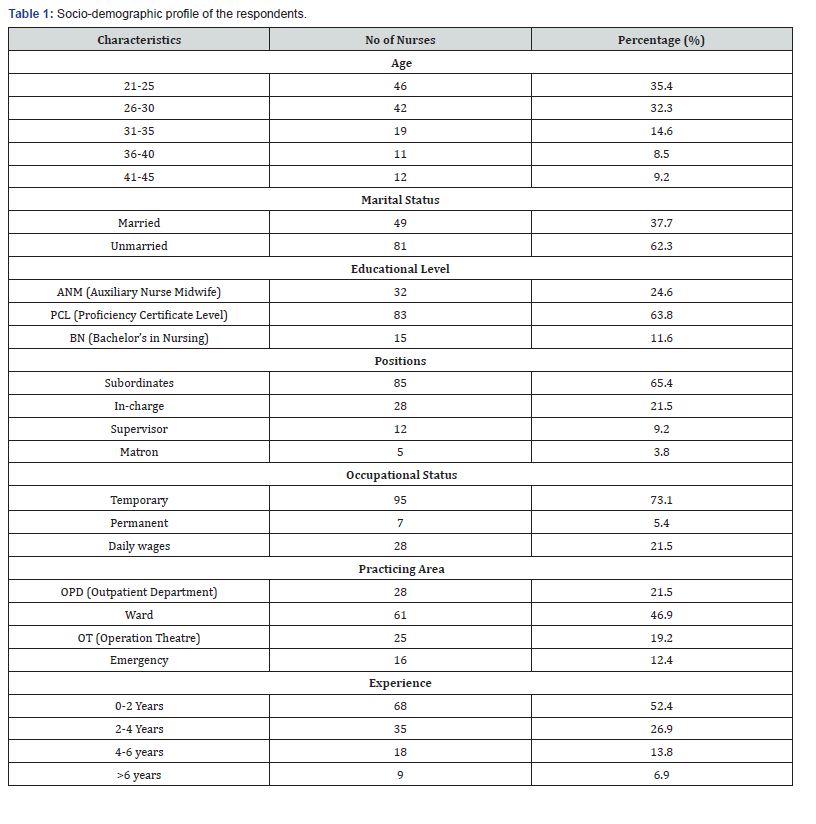
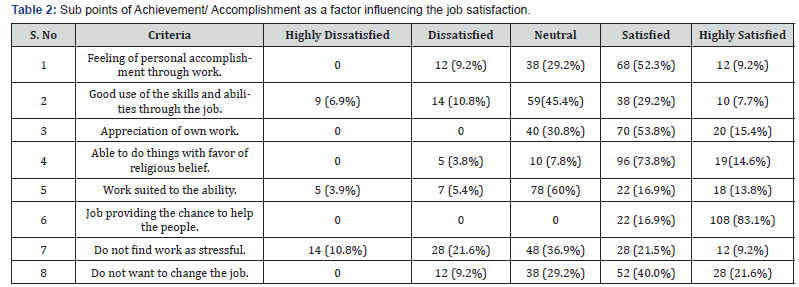

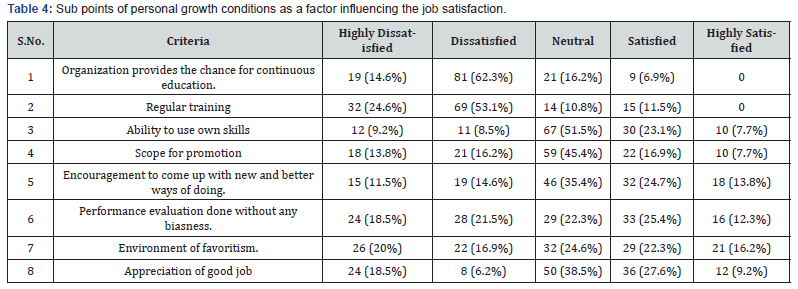




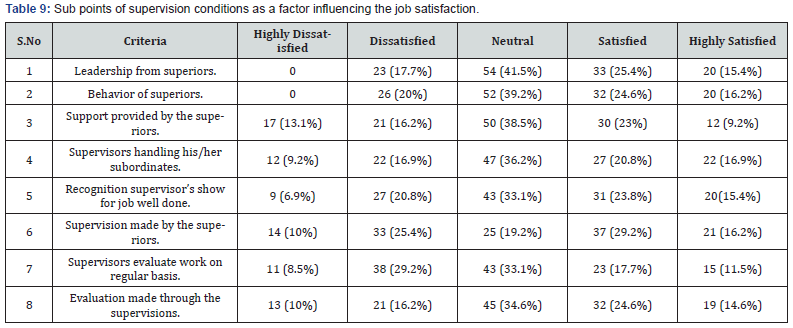
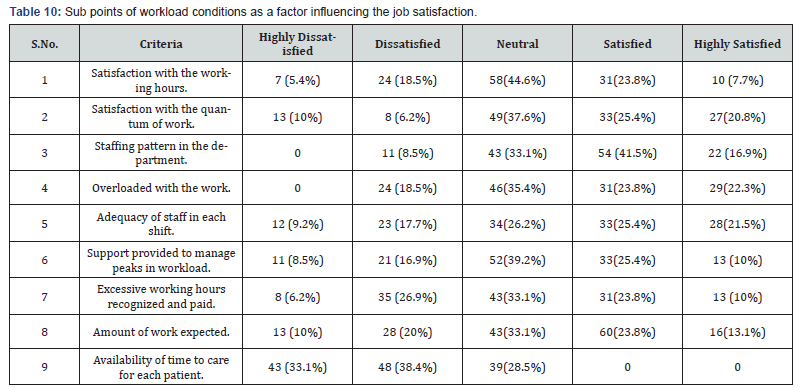
Discussion
A total of 130 nurses completed the questionnaire (response rate 100%) which was similar to the response rate in the study done in Ethiopia 3 and comparable to a study done in Tilganga Eye Centre in Nepal in which the response rate was 90 percent [31,32]. Most of the nurses belonged to younger age group 20- 25 years (35.4%) among them unmarried outnumbered (62.3%). This is due to the fact that nurses after PCL studies are willing to work and want to earn their living themselves and moreover, they need experience for their Bachelor studies. The educational status of most nurses was PCL level i.e. 63.8% and none of them were holding masters level education which was due to unavailability and need for nurses with higher education recognized by private hospitals. Supervisors and Matrons counted for about 13% out of total nurses; 65% of nurses were subordinates. About three-fourth of the nurses had been enrolled as temporary staffs followed by 21.5% were on daily wages however very few remaining were permanent staffs. About one-third of nurses were satisfied with their job due to the fact of being able to do things with favor of religious belief while 47.9% expressed satisfaction with their job (higher satisfaction score was related to moral values i.e. 87.9% followed by social services i.e. 76.1%) in a cross sectional study done in a teaching Hospital in Teharan30 which concluded that the nurses were mostly satisfied with the intrinsic factors of their job when compared with the extrinsic factors. In our study, most of the nurses were highly satisfied i.e. 83% as the job providing the chance to help people followed by 73% of nurses satisfied with the favor of religious belief. More satisfaction is contributed by the intrinsic factors i.e.45.3% rather than the extrinsic factors i.e 38.5% which shows similarity found in Teharan. Regarding the job itself, most of the respondents 68.5% were highly satisfied indicating that their jobs were worthwhile; which is like the results of the study done by Charolette Pietersen [33] in South Africa.
About 10.8% of nurses were highly dissatisfied with the work being stressful and 9.2 % of nurses wanted to change their job. Fifteen percentage of nurses were highly dissatisfied for adequate authority to perform duties effectively while 12.3% enjoyed for having adequate authority. Nurses feeling highly dissatisfied about ability to make decision on own were 8.5% while 12.3% of nurses were highly satisfied for having freedom to choose different work method in the job while 18.4% were against it. Regarding the working condition 14.6 % of nurses were highly dissatisfied for the fact that organization was not providing them the chance for continuous education. 24.6% were also highly dissatisfied about employee training and development opportunities, while 11.5% were satisfied however none was highly satisfied. 12.3% of nurses were highly satisfied about the performance-based evaluation without biasness while 18.5% of them were highly dissatisfied about the performance evaluation. 38.5% of nurses were neutral about the fact being noticed and appreciated while doing a good job. 5.4% of nurses were highly satisfied with the belief that job is secured while 28.5% and 26% were highly dissatisfied and dissatisfied respectively. Majority 13.1 % of nurses were highly dissatisfied to continue the work in same organization; 16.2% were dissatisfied to continue the job while 9.2% were satisfied highly. Majority (68.5%) of nurses were highly satisfied that job makes do something worthwhile and none were dissatisfied. 26.9% of nurses enjoyed the social aspect of the work being highly satisfied while 13.8% of them were dissatisfied.
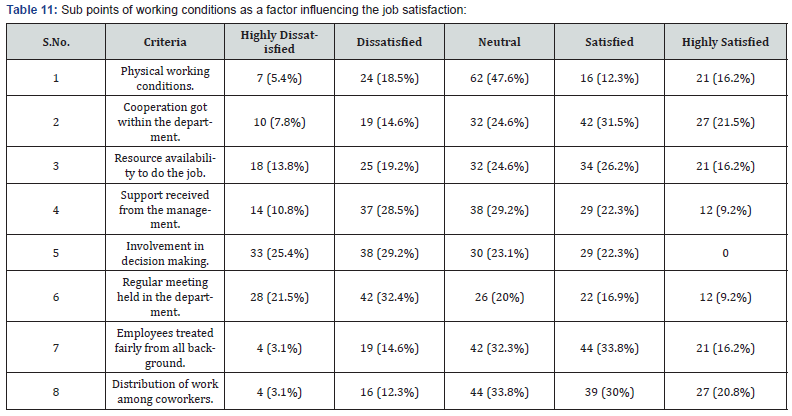
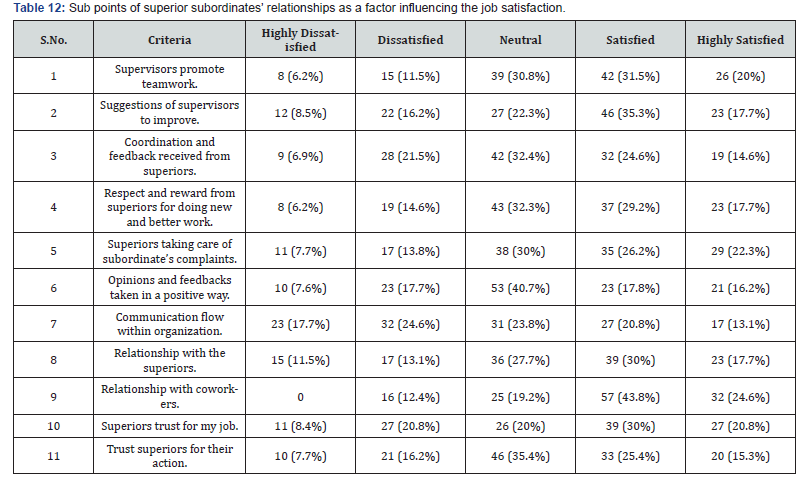



The respondents in a research done in Malaysia by Wai Mun Tang, identified the three highest priority factors i.e. salary, benefits and working conditions that determine the job satisfaction of nurses. Regarding the salary 23.3% were highly dissatisfied and 37.7% were dissatisfied with the current salary while none was highly satisfied. In context with the payment and salary, bonuses and incentives no one was highly satisfied. As per the benefits provided in the organization for health services 17.6% and 36.2% were highly dissatisfied and dissatisfied respectively. 33.8% were dissatisfied with the reward system provided by the organization while 26.2% were satisfied. 53.1% were highly dissatisfied with the retirement plan of the hospital, while 32.3% were neutral about it. In terms of leadership and supervision 15.4 % of nurses were highly satisfied with the leadership from the supervisors, none was highly dissatisfied though 17.7 % were still dissatisfied. None was highly dissatisfied with the behavior of superiorsthough one – fifth of the nurses were dissatisfied. 16.2% were still highly satisfied. 13.1 % were highly dissatisfied with the support provided by the superiors. 10 percent of nurses were highly dissatisfied with the supervision made by the superiors while 16.2% were highly satisfied. 8.5% of them told that they were highly dissatisfied that their supervisors evaluated their work on regular basis while 11.5% were highly satisfied. For working hours 5.4% of nurses were highly dissatisfied while 58% of them were neutral. 16.9% of nurses were satisfied with the staffing pattern in the department and none were highly dissatisfied. None of them were highly dissatisfied with the overload of work but 18.5% were dissatisfied. 33.1% of the nurses were highly dissatisfied with the availability of time to care for each patient while 38.4% of them were dissatisfied. None of them were satisfied with the availability of time to care for each patient (Table 10-15).
Working conditions as a factor influencing the job satisfaction were also analyzed in which 7.8% were highly dissatisfied and 21.5% were highly satisfied with the cooperation got within the department. 13.8% were highly dissatisfied with the resource availability to the job. While the study done in Nigeria proved that 44% of nurses perceived their work environment as an average quality while only few nurses i.e. 3.1% were with high degree of job satisfaction. In contrast to this 45% nurses were satisfied with the working environment allowing them to make autonomous nursing care decision and 36% were reporting dissatisfaction in the study done by Agezegn Asegid et al. [34]. About one fifth of the nurses were highly dissatisfied with the regular meeting held in the department while 32.4% were dissatisfied. Only 9.2% of nurses were highly satisfied. 33.8% of nurses were neutral with the distribution of work among the coworkers while 3.1% were highly dissatisfied. Regarding supervisors promoting and environment of teamwork 6.2% of nurses were highly dissatisfied with the supervisors while one fifth of them were highly satisfied. 6.9% of them were highly dissatisfied with the coordination and feedback received from superiors while 14.6% of them were highly satisfied. Floyd stated that 80% of the nurses reported that the good relationship with doctors was a major source of satisfaction for them [35]. With the communication flow within the organization 17.7% of the nurses were highly dissatisfied while 13.1 % of them were highly satisfied. 11.5% of them were highly dissatisfied with the relationship with the superiors while 17.7% were highly satisfied. None was highly dissatisfied with the relationship with the coworkers. About one fifth of the nurses were highly satisfied with the trusts in them by the superiors. Only 15.3% of them are highly satisfied with the trusts they have on the superiors for their action.
By the level of training opportunities available in their institution the majorities i.e. 53.7% of nurses were not satisfied while only 25.6% reported satisfaction in a cross-sectional study carried out on 278 nurses using both qualitative and quantitative data collection methods interviewed giving a response rate of 87% in Ethiopia [34]. Regarding the clarity of job requirements9.2% of the nurses were highly dissatisfied while 14.6% were highly satisfied. Only 13.1% of them were highly satisfied with the time availability for a tea break. 5.4% of the nurses were highly dissatisfied with the status in the community while about one fourth were highly satisfied. 36.2% of them and 42.3% were highly satisfied and satisfied respectively for making a difference in the life of others; none was dissatisfied or highly dissatisfied on this issue. In terms of intrinsic factors, majority of the respondents in terms of intrinsic factors are satisfied i.e. 45.3% and least i.e. 26.3% were dissatisfied respectively. However, the percentages of respondents regarding the satisfaction and dissatisfaction to the extrinsic factors were 38.5% and 30.8% respectively in context to extrinsic factors.
Conclusion
Thus, job satisfaction in nurses is a burning issue in the health care delivery system in Nepal as well as the importance of it to prevent the manpower drain from this poor country. The small proportionate of nurses were only satisfied with the employee training and development opportunities while majority of them were dissatisfied. None was highly satisfied with the current salary in their hospitals which indicate that the height of exploitation of nurses in private hospitals. Most of the respondents 68.5% were highly satisfied indicating that their jobs were worthwhile. This indicates the realization of job opportunity and the importance of nursing job in the society in our country. Retirement benefits and the empowerment of staffs is one of the main motivating factors in any organization that gives its reputation. Here in this study, 53.1% were highly dissatisfied with the retirement plan of the hospital. In context with the payment and salary, bonuses and incentives no one was highly satisfied. 23.3% were highly dissatisfied and 37.7% were dissatisfied with the current salary while none was highly satisfied. More satisfaction of nurses towards the job is due to intrinsic factors as compared to the extrinsic factors. Only about one fourth of the nurses were highly satisfied with the status in the community which indicates the reason for emigration of nurses out of Nepal. In terms of intrinsic and extrinsic factors only 45.3% and 38.5% of the nurses are satisfied respectively. So, this study is helpful analyzing the current scenario of nursing occupation with its importance and its future. It is the high time to improve the perception towards nurses and to act before a huge skill drains out of our country and the regret for the economic loss used to produce such manpower. Addressing these issues will help to provide quality nursing services in every part of Nepal.
References
- Berry, Lilly M (1997) Psychology at Work. San Francisco: McGraw Hill Companies Inc.
- Wood SE, Wood EG, Boyd D (2007) The world of psychology. Pearson Education Inc, UK.
- Mulugeta Mekuria Ayele Geleto Bali (2015) Factors associated to job satisfaction among health care workers at public hospitals of West Shoa Zone, Oromia Regional State, Ethiopia: A correctional study. Science Journal of Public Health 3(2): 161-167.
- Huey-Ming Tzeng (2002) The influence of nurses ‘working motivation and job satisfaction on intention to quit: an empirical investigation in Taiwan. International Journal of Nursing Studies 39(8): 867-878.
- M Eswari, S Saravanan (2011) A study of job stress among women nurses in Coimbatore City, Tamil Nadu, International Journal of Research in Management & Technology (IJRMT) 1(2).
- Herzberg F (1959) The Motivation to Work. (2nd edn), Wiley, New York.
- Maslow AH (1943) Theory of human motivation. Psychol Rev 50: 370-396.
- Adams A, Bond S (2000) Hospital nurses job satisfaction, individual and organizational characteristics. Journal of Advanced Nursing 32(3): 536-543.
- Aiken L, Clarke S, Sloane D (2002) Hospital nurse staffing and patient mortality, nurse burnout, and job dissatisfaction. JAMA 288(16): 1987-1993.
- Murrells T, Clinton M, Robinson S (2005) Job satisfaction in nursing: validation of a new instrument for the UK. Journal of Nursing Management 13(4): 296-311.
- Ke Liu, Li-Ming You, Shao-Xian Chen, Yuan-Tao Hao, Xiao-Wen Zhu, et al. (2012) The relationship between hospital work environment and nurse outcomes in Guangdong, China: a nurse questionnaire survey. J Clin Nurs 21(9-10): 1476-1485.
- Nepal Nursing Council (2019).
- Ganesh Gurung, Elisa Facchini (2011-12-22) The nurses’ dilemma. The Kathmandu Post.
- Manojlovich M, Spence Laschinger HK (2002) The relationship of empowerment and selected personality characteristics to nursing job satisfaction. Journal of Nursing Administration 32(11): 586-595.
- James Buchan, Tina Parkin, Julie Sochalski (2003) International nurse mobility: trends and policy implications (WHO).
- Borda R, Noma (1997) Factors influencing turnover and absence of nurses: a research review. International Journal of Nusing studies 34(6): 385-394.
- Shrestha GK, Singh B (2010) Job satisfaction among Nurses in a Hospital, Kathmandu. Journal of Nepal Health Res Council.
- Meshal M (2001) Education, job satisfaction, and gender in Kuwait. The International Journal of Human Resources Management 12(2): 311-332.
- Gazioglu S, Tansel A (2006) Job satisfaction in Britain: Individual and job-related factors. Applied Economics. 38(10): 1163-1171.
- Zhang H, Lam T, Baum T (1999) A study of the inter-relationships between job satisfaction and their demographic characteristics. Asia Pacific Journal of Tourisms Research 4(2): 49-58.
- Marwan T Al- Zoubi (2012) The shape of the relationship between salary and job satisfaction: a field study. Far East Journal of Psychology and Business 7(3).
- Nichols K, V Springford, J Searle (1981) An investigation of stress and discontent in various types of nurses. Journal of advanced nursing 6: 311-318.
- Assibi Rita (2013) The causes of stress and job satisfaction among nurses at Ridge and Pantang Hospitals in Ghana. International Journal of Asian Social Science 3(3): 762-771.
- Mahomoud Al- Hussami (2008) A study of nurses’ job satisfaction; the relationship to organizational commitment, perceived organizational support, transactional leadership, transformational leadership and level of education. European journal of scientific research 22(2): 286-295.
- Gifford BD (2002) The relationship between hospital unit culture and nurses’ quality of work life. Journal of Health Care Management (47): 13-25.
- Prothero, Marshall ES, Fosbinder DM (1999) Implementing differentiated practice: Personal values work satisfaction among hospital staff nurses in staff development 15: 185-192.
- Tumulty G, Jernigan LE, Kohut GF (1994) The impact of perceived work environment on job satisfaction of hospital staff nurse. Applied Nursing Research 7 (2): 84-90.
- Johnston CL (1991) Sources of work satisfaction/dissatisfaction for hospital registered nurses. Western Journal of Nursing Research 13(4): 503-513.
- Hong Lu, Alison E, While K, Louise Barriball (2007) Job satisfaction and its related factors: A questionnaire survey of hospital nurses in Mainland China. International Journal of Nursing Studies 44: 574-588.
- Ramin Mehrdad, Nazanin Izadi, Gholamreza Pouryaghoub (2013) Nurse Job Satisfaction: Is a Revised Conceptual Framework Needed? International journal of Hospital Research Article 2(2): 55-60.
- Mohite N, Shinde M, Gulavani (2012) Job Satisfaction among Nurses Working at Selected Tertiary Care Hospitals. International Journal of Science and Research 3(6): 1006-1012.
- Nawa Raj Chaulagain, Deepak Kumar Khadka (2012) Factors influencing Job satisfaction among Health care professionals at Tilganga Eye Centre, Kathmandu Nepal. International Journal of scientific & Technology Research 1(11).
- Charlotte Pietersen (2005) Job satisfaction of Hospital Nursing Staff. SA Journal of Human resource Management 3(2).
- Agezegn Asegid, Tefera Belachew, Ebrahim Yimam (2014) Factors influencing Job satisfaction and anticipated turnover among nursesin Sidama Zone Public Health Facilities, South Ethopia. Nursing Research & Practice.
- Floyd GJ (1983) Psychiatric Nursing Aides. Nursing Management 14(9): 36-40.






























